Replication inhibitors modulate instability of an expanded trinucleotide repeat at the myotonic dystrophy type 1 disease locus in human cells
- PMID: 14574643
- PMCID: PMC1180489
- DOI: 10.1086/379523
Replication inhibitors modulate instability of an expanded trinucleotide repeat at the myotonic dystrophy type 1 disease locus in human cells
Abstract
Gene-specific CTG/CAG repeat expansion is associated with at least 14 human diseases, including myotonic dystrophy type 1 (DM1). Most of our understanding of trinucleotide instability is from nonhuman models, which have presented mixed results, supporting replication errors or processes independent of cell division as causes. Nevertheless, the mechanism occurring at the disease loci in patient cells is poorly understood. Using primary fibroblasts derived from a fetus with DM1, we have shown that spontaneous expansion of the diseased (CTG)(216) allele occurred in proliferating cells but not in quiescent cells. Expansions were "synchronous," with mutation frequencies approaching 100%. Furthermore, cells were treated with agents known to alter DNA synthesis but not to directly damage DNA. Inhibiting replication initiation with mimosine had no effect upon instability. Inhibiting both leading- and lagging-strand synthesis with aphidicolin or blocking only lagging strand synthesis with emetine significantly enhanced CTG expansions. It was striking that only the expanded DM1 allele was altered, leaving the normal allele, (CTG)(12), and other repeat loci unaffected. Standard and small-pool polymerase chain reaction revealed that inhibitors enhanced the magnitude of short expansions in most cells threefold, whereas 11%-25% of cells experienced gains of 122-170 repeats, to sizes of (CTG)(338)-(CTG)(386). Similar results were observed for an adult DM1 cell line. Our results support a role for the perturbation of replication fork dynamics in DM1 CTG expansions within patient fibroblasts. This is the first report that repeat-length alterations specific to a disease allele can be modulated by exogenously added compounds.
Figures
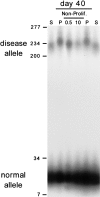
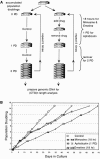
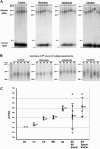
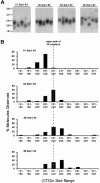
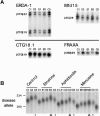
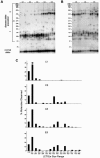
Similar articles
-
Oligodeoxynucleotide binding to (CTG) · (CAG) microsatellite repeats inhibits replication fork stalling, hairpin formation, and genome instability.Mol Cell Biol. 2013 Feb;33(3):571-81. doi: 10.1128/MCB.01265-12. Epub 2012 Nov 19. Mol Cell Biol. 2013. PMID: 23166299 Free PMC article.
-
Maternal germline-specific effect of DNA ligase I on CTG/CAG instability.Hum Mol Genet. 2011 Jun 1;20(11):2131-43. doi: 10.1093/hmg/ddr099. Epub 2011 Mar 5. Hum Mol Genet. 2011. PMID: 21378394
-
Bidirectional transcription stimulates expansion and contraction of expanded (CTG)*(CAG) repeats.Hum Mol Genet. 2011 Feb 1;20(3):580-8. doi: 10.1093/hmg/ddq501. Epub 2010 Nov 18. Hum Mol Genet. 2011. PMID: 21088112 Free PMC article.
-
Overview of the Complex Relationship between Epigenetics Markers, CTG Repeat Instability and Symptoms in Myotonic Dystrophy Type 1.Int J Mol Sci. 2022 Mar 23;23(7):3477. doi: 10.3390/ijms23073477. Int J Mol Sci. 2022. PMID: 35408837 Free PMC article. Review.
-
Modifiers of CAG/CTG Repeat Instability: Insights from Mammalian Models.J Huntingtons Dis. 2021;10(1):123-148. doi: 10.3233/JHD-200426. J Huntingtons Dis. 2021. PMID: 33579861 Free PMC article. Review.
Cited by
-
Mitigating RNA Toxicity in Myotonic Dystrophy using Small Molecules.Int J Mol Sci. 2019 Aug 17;20(16):4017. doi: 10.3390/ijms20164017. Int J Mol Sci. 2019. PMID: 31426500 Free PMC article. Review.
-
Microsatellite repeat instability and neurological disease.Bioessays. 2009 Jan;31(1):71-83. doi: 10.1002/bies.080122. Bioessays. 2009. PMID: 19154005 Free PMC article. Review.
-
Impaired DNA replication prompts deletions within palindromic sequences, but does not induce translocations in human cells.Hum Mol Genet. 2009 Sep 15;18(18):3397-406. doi: 10.1093/hmg/ddp279. Epub 2009 Jun 11. Hum Mol Genet. 2009. PMID: 19520744 Free PMC article.
-
Epigenetic changes and non-coding expanded repeats.Neurobiol Dis. 2010 Jul;39(1):21-7. doi: 10.1016/j.nbd.2010.02.004. Epub 2010 Feb 18. Neurobiol Dis. 2010. PMID: 20171282 Free PMC article. Review.
-
Tissue- and age-specific DNA replication patterns at the CTG/CAG-expanded human myotonic dystrophy type 1 locus.Nat Struct Mol Biol. 2010 Sep;17(9):1079-87. doi: 10.1038/nsmb.1876. Epub 2010 Aug 15. Nat Struct Mol Biol. 2010. PMID: 20711191
References
Electronic-Database Information
-
- Fisher’s Exact Test Web site, http://matforsk.no/ola/fisher.htm
-
- Online Mendelian Inheritance in Man (OMIM), http://www.ncbi.nlm.nih.gov/Omim/ (for DM1) - PubMed
References
-
- Anvret M, Ahlberg G, Grandell U, Hedberg B, Johnson K, Edstrom L (1993) Larger expansions of the CTG repeat in muscle compared to lymphocytes from patients with myotonic dystrophy. Hum Mol Genet 2:1397–1400 - PubMed
-
- Ashizawa T, Monckton DG, Vaishnav S, Patel BJ, Voskova A, Caskey CT (1996) Instability of the expanded (CTG)n repeats in the myotonin protein kinase gene in cultured lymphoblastoid cell lines from patients with myotonic dystrophy. Genomics 36:47–53 - PubMed
-
- Benitez J, Robledo M, Ramos C, Ayuso C, Astarloa R, Garcia Yebenes J, Brambati B (1995) Somatic stability in chorionic villi samples and other Huntington fetal tissues. Hum Genet 96:229–232 - PubMed
-
- Breschel TS, McInnis MG, Margolis RL, Sirugo G, Corneliussen B, Simpson SG, McMahon FJ, MacKinnon DF, Xu JF, Pleasant N, Huo Y, Ashworth RG, Grundstrom C, Grundstrom T, Kidd KK, DePaulo JR, Ross CA (1997) A novel, heritable, expanding CTG repeat in an intron of the SEF2–1 gene on chromosome 18q21.1. Hum Mol Genet 6:1855–1863 - PubMed
Publication types
MeSH terms
Substances
LinkOut - more resources
Full Text Sources
Other Literature Sources

